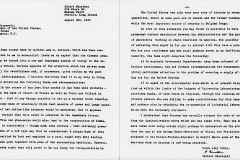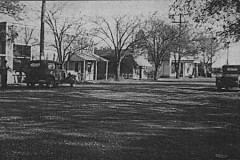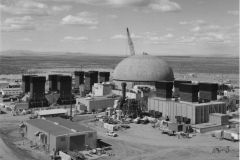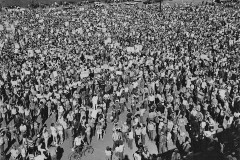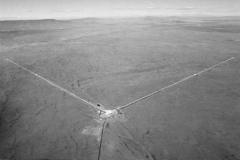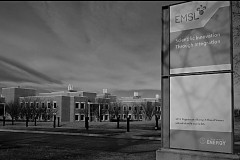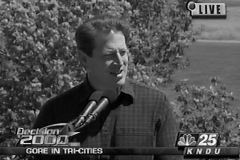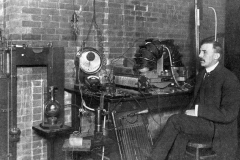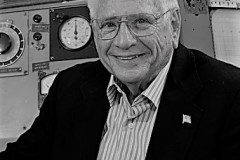Something Extraordinary
A SHORT HISTORY OF THE MANHATTAN PROJECT, HANFORD, AND THE B REACTOR
Synopsis

Finally, a concise but comprehensive narrative of the geopolitics and atomic research that led to the creation of the Manhattan Project—the American effort to develop and deploy the atomic bomb during World War II. Written by two award-winning authors who together bring more than a century of direct experience with the subject, this book is unlike any other.
A key component of the Manhattan Project was the development of the massive Hanford Site where the plutonium used in America’s atomic bombs was produced. The book celebrates the 75th anniversary of the date in 1944 when the first production reactor, the B Reactor, went critical and the plutonium it produced helped win the war. The year 2019 is also the 35th anniversary of the startup of WNP-2, now the Columbia Generating Station, the only nuclear power reactor to be built by the Washington Public Power Supply System. Also, this year is the 30th anniversary of the signing of the Tri-Party Agreement, which governs the cleanup of the Hanford Site.
Hanford and the B Reactor played an important role in the Cold War and in the growth and subsequent economic fortunes of the nearby Tri-Cities communities whose economies were directly affected by events at Hanford. When the plutonium production reactors and chemical separation facilities were deactivated, the community sought to find new missions and uses for the Hanford Site. By the 1980s, it was clear that Hanford’s mission had finally changed from production to cleanup, ushering in a whole new set of challenges and opportunities that continue to this day.
It’s all here, from the history of atomic research to the continuing efforts to clean up the Hanford Site. Written for non-technical readers who may be first-time visitors to the Tri-Cities or the B Reactor—now part of the Manhattan Project National Historic Park—or for those who have lived and worked around the Hanford Site and may want a brief and easy-to-read history of their community.
Robert L. Ferguson and C. Mark Smith share almost a century of federal, state, and local leadership experience between them. Ferguson, a nuclear physicist, is a recognized authority on nuclear energy and waste management issues, economic development leader, philanthropist, and author of two books. Smith managed economic development organizations at the federal, state, and local level for more than forty years and is the author of four books of history and biography, three of them involving the history of the Tri-Cities.
Fact Sheet
Excerpt
Reviews
Gallery
Fact Sheet
Fact Sheet
| Title | SOMETHING EXTRAORDINARY: A Short History of the Manhattan Project, Hanford, and the B Reactor |
| Author | Robert L. Ferguson and C. Mark Smith |
| Publication Date | Late Summer, 2o19 |
| Marketing Plan | Personal appearances, media interviews, Internet, Facebook, historical societies, libraries, independent and online booksellers |
| Audiences/Markets | Manhattan Project (U.S.)—History. | Hanford Site (Wash.)—History. | B Reactor National Historic Landmark (Wash.)–History. | Atomic bomb–Unite States–History–20th century. | Plutonium industry–Washington (State)—Hanford—History–20th century. | Nuclear weapons–Materials. | Hanford (Wash.)–History 20th century. | Washington (State)–economic conditions–20th century. | Hazardous waste site remediation–Washington (State)–Hanford Site. |Nuclear weapons plants–Waste disposal–Environmental aspects–Washington (State)—Hanford Site. |Environmental monitoring—Washington (State)—Hanford Site. |
| Binding | 6 x 9 Perfect Bound |
| Features | 250 Pages, 9 Chapters, 92 Photographs, Chronology, Appendix, Endnotes, Bibliography, Index |
| ISBN | 978-1-948963-27-5 Book 978-1-948963-28-2 E-book |
| LCCN | 2019908463 |
| Price | $19.95 |
| Publisher | Book Publishers Network, info@bookpublishersnetwork.com (425) 482-3040 or (877) 483-3040 |
| Distributor | Ingram |
| Website | www.cms-author.com | www.bobferguson-legacymatters.com |
| https://www.facebook.com/CMS-Author-218591854970150/ | |
| Author Contact | cmsmith@cms-author.com | (509) 628-9575 |
SOMETHING EXTRAORDINARY: It celebrates the 75th anniversary of the date in 1944 when the first nuclear reactor at Hanford—the B Reactor—went critical and produced the plutonium that helped win the war.
Excerpt
Excerpt
Work on the B Reactor was finally finished by August 19, 1944, less than two years after Fermi and his team had achieved the world’s first chain reaction in Chicago and about thirteen months after the start of construction at Hanford. Enrico Fermi personally supervised the first loading of uranium slugs into the reactor on September 18, a month before the US invasion of the Philippines.
DuPont’s Crawford Greenwalt was there. He had witnessed the first chain reaction in Chicago. So was Leona Marshall Libby, then twenty-five and the only female member of Fermi’s team, who remembered that “some of those who had worked so hard for so many months” smelled “pleasantly of a drink or two of good whiskey.”
Fermi directed the removal of the control rods, as he and the others watched the power level of the reactor climb to nine million watts—a fraction of the reactor’s 250-million-watt-design capacity—stall and then slowly die. The same thing happened the following day. Was it possible something that had cost so much and consumed so many valuable resources didn’t work?
Something was poisoning the nuclear reaction. Fermi, Marshall, and others quickly determined the cause was an isotope of the element xenon, a byproduct of nuclear fission, which was able to capture enough neutrons to slow and then stop the reaction, although the reactor could be restarted about twelve hours later after xenon decayed. This effect, known as poisoning, had not been detected at the Oak Ridge pilot plant because of its much smaller size (1 megawatt compared to 250 megawatts).
The problem was resolved quickly because DuPont’s conservative engineers had earlier made a decision to build the reactor core to accommodate a larger number of uranium slugs than its designers had thought necessary. As a result, Fermi and DuPont’s operators were able to load additional slugs of uranium into the pile, overcoming the effect of the xenon and sustaining the reaction.
Chapter 6, page 90-91
Reviews

Reviews
“Robert L. Ferguson and C. Mark Smith’s Something Extraordinary: A Short History of the Manhattan Project, Hanford, and the B Reactor provides an accessible and thorough overview of one of the most important developments of twentieth century global history: the rise and decline of the nuclear age. Focusing on Hanford, Washington and its B Reactor—the world’s first large-scale nuclear production facility—the book skillfully traces that story through four key anniversaries dating from 2019: German aggression leading to the outbreak of World War II and the Manhattan Project in 1939; the development of the Hanford Site and the startup of B plutonium production reactor in 1944; the inauguration of the WNP-2 nuclear power reactor in 1984; and the Tri-Party Agreement of 1989 and subsequent efforts to cleanup nuclear waste. As Ferguson and Smith ably demonstrate, despite their remote location, Hanford and B Reactor were at the center of the technological developments, and the subsequent environmental damages, that would come to define that age.”
Michael Mays Director, Hanford History Project
“As a member of Congress and chairman of its Nuclear Cleanup Caucus, I was intimately involved with the activities at Hanford. Growing up and living in Pasco since the 1940s, I had a first-hand view of the changes that it brought to the Tri-Cities community. It is all described in this short, but fact-filled history of the Manhattan Project, Hanford, and the B Reactor, including an extensive chronology to help follow the story. Highly recommended!”
Doc Hastings Member of Congress | 1995-2015
“Something Extraordinary is the best overview of the history of the Hanford site to date. Expansive in its breadth of coverage from the discovery of radiation to the intrigue surrounding the formation of the Manhattan Project and race for the atom bomb; and patient in its explanation of the many legacies of Hanford, including the legacy of nuclear waste.”
Robert Franklin,
President of the B Reactor Museum Association
“Bob Ferguson and Mark Smith have written an accurate, accessible, and informative history of the Hanford project all the way from the beginnings of the Manhattan Project through 2019. The book is especially good at connecting the World War II years to the Cold War and then the Cold War years to the post-Cold War cleanup years. Ferguson and Smith know the Tri-Cities area well and are able to connect local issues to national and international developments. This is an excellent guide for anyone who’s thinking about visiting Hanford or who wants to know more about the area.”
Steve Olson
“If you want to know about the Manhattan Project, Hanford and the B Reactor, you will be so pleased to read the first eight pages, front and back, of this book’s Chronology. I know some of its history because I worked 30 years on Hanford project and I also know these authors. The book will continue to be outstanding.”
Robert Larson
“This book had the perfect level of detail: enough to educate someone like me who is totally unfamiliar with the project, but not so much that it swamps my brain. I particularly liked how it covered events right up to the current year.”
Voracious Reader

